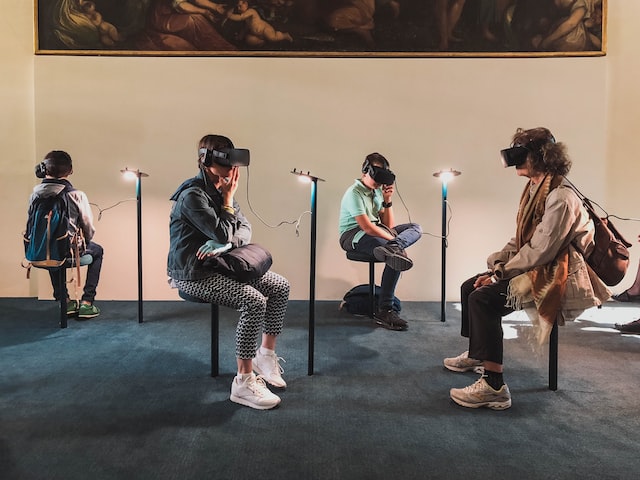
GUEST POST from Diana Porumboiu
Brainstorming is one of those hyped terms that these days has a reputation of its own because of the controversy surrounding it. Is it just a shallow activity, organizations do when they are stuck in a rut? Or is there an efficient way to go about it without wasting time?
The debate still goes on, and both sides have valid arguments. The opposing sides of the debate are the experienced facilitators or managers who vouch for its value when done right, and the academic research that points out the flaws and the short-sightedness of the approach.
But we don’t live in a black and white world, and as is the case with most things, brainstorming is more nuanced than that. Since brainstorming first became a thing, in the ‘50s, the world has changed radically. In the past 70 years, we got the Internet, we went digital, and our working life looks completely different.
Even so, the basic rules of brainstorming haven’t really adapted to these new realities. So instead of asking ourselves if there is a point in brainstorming, and whether it’s good or bad, maybe we should update the old ways of brainstorming to make it more effective for modern organizations.
So, in this article, we’ll answer essential questions like what the value of brainstorming is, and provide practical steps and up-to-date rules of thumb that can lead to effective brainstorming sessions.
But without further ado, let’s get to it.
What is brainstorming and what’s the hype around it?
To set the scene, let’s recap what brainstorming is and how it became such a key concept in creative thinking.
In a nutshell, brainstorming refers to the group ideation technique where people get together for a session to generate and contribute ideas around a specific theme or problem.
Nowadays, brainstorming is the overarching term for a variety of methods, tools, and techniques that have been developed to facilitate creativity and encourage idea generation.
As a short background story for those who are not familiar with the source of brainstorming, Alex Osborn is considered the father of this method. A creative theorist, and businessman he imagined the technique in the 50s, and was actively using it in his agency, BBDO. Reportedly, every day they were running a brainstorming session, in a bright yellow room where up to 12 people would gather to bounce around ideas. After 401 sessions, they had a total of 34000 ideas, which in the end resulted in 2000 good ideas.
If we do the math this translates to 5 decent ideas per session. 70 years ago, this might have looked like a good use of time, but considering today’s technologies and methods, those results could be achieved with far less effort and way faster. Current tools allow easier and faster idea collection, which leaves more time for actual development and implementation work.
Brainstorming caught the attention of researchers in the academic world, which made this one of the most researched creative thinking methods. This is also how the technique became very controversial.
The first ones to show interest in brainstorming were researchers at Yale, whose studies led to an unexpected outcome: individual ideation led to more ideas than group ideation. As academic settings are different from corporate ones, understandably the results were not deemed reliable.
The Traditional Rules of Brainstorming and Their Benefits
Osborn came up with the brainstorming technique as a tool to generate a large number of ideas for a specific problem. Brainstorming, which he initially called thinking up was grounded in a few basic rules that would govern each session.
1. Quantity first: come up with as many ideas as possible and the winning ideas will eventually come.
Ideas are the main purpose of a brainstorming session, so we couldn’t agree more, you want as many as possible. However, when it comes to traditional brainstorming sessions, you drastically reduce the number of ideas that could be generated.
The traditional approach suggests getting together 10 to 12 people who can work together. There’s an obvious limitation to this approach, as we saw in Osborn’s results, they needed over 400 sessions to get to 2000 decent ideas.
Limiting access to only a select few, is diminishing opportunities and the number and diversity of ideas that could be generated. It might have worked well in a small agency and in the 50’s offices, but in today’s complex and global work environments, this approach is highly restrictive.
When people work remotely or from different corners of the world, it is highly inefficient to get them together for a brainstorming session. Let alone involve those who don’t happen to work in the figurative Ivory Tower at headquarters. Ideas should come from all employees in an organization, not just from top managers.
2. Encourage bold, crazy ideas
Don’t rule out any ideas because you never know where a spark can come from. The risk with this rule is that people have the tendency to focus more on pointing out problems than solutions. But this doesn’t mean that there is no value in that. Even if the solution isn’t right, you might uncover something that was not obvious up to that point that helps you solve the right problem down the road.
Opening the door to wild ideas can come with the challenge of keeping people focused on the goal, especially since the next rule makes it even harder to get participants back on track when they veer away from the purpose of the session.
3. No evaluation or criticism of ideas
Understandably, the role of this rule is to not discourage or cut people off from churning out a flow of ideas. As the best ideas often build on top of other people’s ideas, this is as an important rule.
However, it also leads to some issues. Even though fostering a safe environment is essential in creative thinking, a brainstorming workshop won’t do the trick. Building a safe environment comes from the overall organizational culture and can’t be suddenly created when brainstorming if it was nonexistent before.
Even though on paper this is a good rule to balance the flow of ideas and give voice to everyone, in practice you will always have the most extrovert, open person in the room speak more and drown out others. Someone more opinionated or with a stronger personality could easily discourage the more reserved, introverted people. And this can happen even when enforcing this rule. Some people will always feel more comfortable speaking up than others.
Also, if there is no instant reaction and no healthy debate, groupthink will settle in. The last rule of brainstorming is meant to combat this, but can it?
4. Combine and improve ideas
Osborn was not wrong to believe in the creative power of a group and in his circumstances, he made it work. When ideas are transparently shared, it’s easier for people to contribute, build upon those and get more creative together.
At the same time, the proponents of brainstorming tend to blame the critics of the method for being inexperienced, unskilled, or simply ignorant. Basically, they don’t see any flaws in the method.
There might be a grain of truth there, but it’s just one side of the story. Even skilled facilitators have a hard time choosing and using the right tools to reach their goals. Sometimes you can expose yourself to others’ ideas at your own pace, when you can digest the information, not when your boss asks you to be creative.
To harness these ideas and moments, organizations should enable the transparent flow of ideas in an asynchronous approach. This will enable them to leverage the creative and collaborative power of hundreds and even thousands of people.
Luckily, modern technology and the myriad of tools available today allow for simultaneous interaction between thousands of people who can transparently collaborate and build on top of each other’s knowledge a snd ideas.
It’s interesting to note that even though these ground rules were first introduced in the 50s, they are mostly valid, and can still be relevant in small agencies and working groups that need a fast fix to a specific issue.
When vouching for brainstorming, many supporters of the method bring up two important benefits:
- Synergy, (which comes from the fourth rule of brainstorming) and
- Social facilitation
Synergy
In essence, synergy refers to the results produced by collaborative work. When people get together, the overall result is greater than the impact they would have had individually.
So, when it comes to brainstorming the ideas generated by some can inspire and motivate others to come up with more ideas. It generates a chain reaction that enables people to build on top of each other’s ideas.
However, organizations are highly complex these days and information is spread across teams, departments and functions.
There are also many other things at play when it comes to team dynamics and human behavior when we interact in person.
For example, the more cohesive a group, the greater the risk of groupthink, conformity, and the tendency to want to reach unanimity. There is also the risk shift issue, which is the tendency of a group to make riskier decisions than they would have made individually.
Then there is also the social loafing concept which refers to how people work less hard for ideas when in a group, rather than if they were doing it alone.
A study on group performance also brought to discussion another phenomenon: downward norm-setting, where a group performs at the level of the weakest person.
Teamwork and cohesive groups are essential for the well-functioning of an organization, but there is always the flip side of the coin. While all these things are not bad per se, they do inhibit the possibility of great, diverse, out-of-the-box ideas. The vacuum in which brainstorming tends to operate, can favor such behaviors which can become bottlenecks for the idea-generation process.
Social facilitation
Again, this is a vast topic, but the main idea here is that people tend to behave differently when in the presence of others. Some research states that people perform better certain tasks when they are with other people than when they are alone.
These theories are hard to prove or explain even for social scientists, so in the context of brainstorming, it’s even more controversial to state that mere collaboration with others can improve one’s performance. There are just too many factors at play.
One of the most obvious is that each brainstorming brings together different personality types. Not everyone will feel energized by the chaos that some brainstorming sessions can turn into. From the personal experience of the introvert writing this piece, brainstorming sessions can be energy-draining, exhausting exercises, and not the most inspiring, motivating types of work meetings.
Most leaders who decide to run a brainstorming workshop do it for one or more of these reasons:
- A fun activity to energize and motivate the team (as mentioned, it hardly applies to everyone, since you will never have completely homogeneous teams, something you shouldn’t even strive for)
- Improve communication and get people on the same page (indeed, when you bring people in the same room it’s easier to communicate the same thing to everyone and bring clarity).
- They involve people in decision-making or at least give that illusion. In some cases, it can work, as people engage and feel motivated when they are listened to. But over time if their ideas are ignored, cynicism can creep in and people will stop believing and engaging in these workshops.
The main purpose of brainstorming, which is creative thinking and idea generation is mostly overlooked, but for these other benefits, it can still be a valuable exercise, especially in small teams and organizations.
That being said, for medium to large organizations who want to make the most of the basic idea of brainstorming, generate as many ideas as possible and get the best results, there are better ways to go about this. Some new, up to date rules, and tools, should be considered if you want to brainstorm in a 21st-century organization.
So, let’s see why and how you can revamp the traditional rules of brainstorming and bring them to modern working life.
The Improved Rules of Brainstorming
Before diving deeper into each of these rules, let’s start by setting the scene of brainstorming: when should you brainstorm, and what are the prerequisites that would make the effort worthwhile.
The most common criticism towards brainstorming is that it doesn’t build momentum and things come to a halt once the session has ended. The reasons could be:
- There is no systematic process in place to manage ideas and to include ideation methods in these processes
- The goals where not clearly defined before the brainstorming. Closely linked to the previous reason, there was no accountability for the outcome of the session and no one in charge of moving ideas further.
So, before jumping into a brainstorming session take a moment and reflect on the purpose. Are there other possibilities, tools, and solutions that might work better?
For example, in recent years a new concept has gained traction, painstorming. If we disregard the not so inspired choice of words, there’s actually something to it.
With painstorming the focus is shifted towards fixing customers’ pain points, so you work to uncover pain points and come up with better ideas around those. Of course, there is nothing new about it, but when you look at why you wanted to brainstorm in the first place, this might bring a new perspective, and with it, new methods and tools, like the Jobs To Be Done framework or How Might We statements.
Of course, these tools aren’t mutually exclusive or replace the need or role of brainstorming. So, if you decide that brainstorming is still something you want to do, you might as well do it right. Here are some amendments to the traditional rules of brainstorming.
1. Quantity: for more ideas, go virtual
As already mentioned, we stand by this rule: to get the best ideas you need a larger pool of ideas to choose from. And in the digital world we live in, you can’t rely just on pen and paper for that.
It’s simple: if you want more ideas, you need more input and more participants, which in an office setting is hard to achieve. We can’t imagine brainstorming with 30 people in the same space; how they would interact, take turns, suggest ideas, how long it would last, and what the outcome would be. Even finding a calendar slot that works for all 30 participants will likely take months. But we can imagine a hybrid workshop with 30 participants or even a completely virtual brainstorming session with hundreds of people.
There are even studies that show how virtual brainstorming sessions are more productive because the environment can provide a better experience for the group members, balancing introverts and extroverts, optimists, and pessimists.
2. Encourage bold, crazy ideas: create the right environment
The crazy ideas come in the most unexpected moments, so don’t miss the opportunity of capturing those. Ideas should not be tied to a place or a moment and because you rarely have the wildest ideas on the spot in a brainstorming session, it’s best to provide the tools and create the processes that allow for idea generation and collection anywhere, and at any time.
That’s also why going virtual is essential. The standard approach is to squeeze some juicy ideas during brainstorming, or to dump them in a collaboration tool as a DM or in a group, where it will probably get lost among the hundreds of messages and conversations.
An idea management tool gives you the freedom and flexibility to come up with ideas at any moment. Then you can discuss them, build upon them, and develop even better ones before, during, or after your brainstorming session.
3. No evaluation, or criticism of ideas: for healthy debates, nurture creative abrasion
Another big topic that goes far beyond brainstorming is the culture in which these sessions take place. The premise is not wrong: you don’t want people to feel intimidated, so you don’t criticize or put their ideas down.
The backbone of brainstorming is collaborative work, but to collaborate doesn’t mean to agree with others all the time. In fact, we get better ideas through debate and discourse.
While Steve Jobs is to this day labeled as a bad leader for his aggressive style and insensitive ways, we could see how his approach helped build a couple of the most innovative companies in the world. Between his style and today’s overly polite approach to conflicting ideas, there is a middle ground: creative abrasion, the ability to create a marketplace of ideas through debate and discourse.
Creative abrasion is not about creating conflict, and irritating group members. It’s about creating cultural, disciplinary, and thinking style diversity, encouraging diversity of ideas, and managing the resulting abrasion for maximum creativity.
To have creative abrasion you need a work environment that provides psychological safety, where people feel safe to advocate for their point of view and disagree with their colleagues or even superiors. Ideas should be challenged, and so should people. If you are a facilitator, ask questions like “what happens if…”, “have you thought of…” or “how might we…”?
You can read more about the topic of psychological safety in our article on how to lead innovative teams.
4. Combine and improve ideas: turn the sessions into a process
A good rule that could also use some refinement to make it even better. In the traditional setting, once ideas are generated and collected, people are expected to react to the pool of ideas they have in front of them. Yet again, there is no such thing as a stroke of genius, the a-ha moment that comes spontaneously.
The key here is to give people the time to reflect on what they’ve learned, research and work on those ideas in order to come up with novel, updated versions of those ideas. In traditional brainstorming, all of that should happen in the same session.
However, this is not something you can do in one session. It’s not just the conclusion of Yale researchers. Jake Knapp, inventor of the design sprint method, and author of Sprint, was using brainstorming workshops at Google for years, until he realized the outcome was not the expected one. Individual ideas that were thought through, of people who took the time to think and analyze, were better and more valuable than those that came out of the brainstorming workshops.
So, what you can do instead is to turn brainstorming into a primarily asynchronous collaborative process that includes a few joint sessions where people can come together to discuss, debate, and find alignment.
If you want to rush brainstorming into a few hours session and expect great results from that, there might be no point in brainstorming at all. You might as well just ask some experts for their input on that specific issue or challenge. And you might still get better results than doing rushed brainstorming sessions.
With these new rules in place, let’s see how you can organize and run successful brainstorming sessions.

How to Setup a Virtual or Hybrid Brainstorming Session
The most exciting part is always getting our hands dirty. Before getting started you need to decide on a shared collaboration tool that is easy to take into use, flexible, and intuitive for everyone to contribute. Ideally, you will choose a tool that doesn’t allow just idea collection, but can support multiple simultaneous idea management processes, can be easily customized, and allows evaluation, transparency, and participation from different kinds of stakeholders, both inside and outside the organization.
The right tool will enable you to run both virtual and hybrid brainstorming sessions where you have some teams remote and others in-person.
1. Set the stage
This first step takes us back to the last rule on the list. Start by defining the process(es) for the sessions you wish to organize.
What is the main goal and focus that will guide the session? It’s best to start your workshops, brainstorming or idea challenges by deciding on the process that best fits your situation.
2. Set up the environment for idea collection
At this stage, you should already know who will be responsible for monitoring the process, who will participate, and what channels of communication will be used. As an example, we used Viima’s brainstorming board template which has the right settings already in place.
This will allow you to communicate in advance the why, what, and how and invite people to participate. For easier monitoring and better organization, create different types of categories of ideas you are looking for. These can be around solutions, opportunities, challenges or problems you want to solve.
3. Generate, collect, and organize ideas
If you’re running a hybrid or an in-person brainstorming, make sure to send the agenda beforehand. This will give people time to prepare, think about the topic and make research if necessary. If your brainstorming is part of a longer process, like an idea challenge and you run it asynchronously, you should set a deadline for submitting ideas.
Ask participants to contribute in advance so that during the brainstorming session you can focus on discussing and refining those ideas.
It’s also good to define the development process of ideas through statuses that indicate where certain ideas are in the process.
For example, for the purpose of brainstorming you can have ideas collected before the sessions, and during the sessions. After the brainstorming and based on data you collected, ideas with potential can change status and move to the next phase. This could be, for example, a new session to discuss and work on the remaining ideas.
Encourage participants to build upon other ideas by commenting and providing their own insight and expertise.
4. Evaluate
An idea evaluation process to get the information that will allow you to make the best possible decision. When evaluating ideas you need a set of criteria, or metrics to consider the various aspects of an idea. When you combine these metrics you get a numeric rating, the score, which can provide an estimate for the potential of the idea.
A systematic set of criteria for evaluating ideas will help you take better and more consistent decisions. However, these criteria vary greatly depending on the industry, type of ideas, strategic objectives, etc.
What is the impact of the idea, how much effort it requires to implement it, and so on. Some of these metrics are best evaluated by managers or subject matter experts, while others can be evaluated by other participants in the brainstorming, based on their own knowledge and involvement in the process.
This is where many brainstorming sessions end. But in reality, this is just the beginning. Once you are done with the brainstorming, idea collection, and evaluation, you need to prioritize them and decide on the next steps. All these steps should be transparent, so people understand the reasons behind certain decisions, why some ideas might be left behind and why others are considered.
5. Prioritize and follow-up
This is the step where the magic of a good idea management tool comes in play. An idea management tool can help you prioritize and select the ideas that meet your criteria and get the highest score.
At this point, you can choose a few ideas to go forward with and prepare for the next session and invite people on an even more focused brainstorming around those ideas.
If you get to one idea with high potential, you can zoom in on that, move it to another session for validation, or maybe even create a new board to collect more ideas around the development and refinement of the “winning idea”.
Before you get to implementation, depending on the complexity of the ideas you’ll be working on, you can repeat the process.
Conclusions
As mentioned above, brainstorming should only be a starting point, a piece in the puzzle of the internal processes you’ve worked hard to develop.
To wrap up let’s recap some of the main points we believe you should take away from this.
- First, don’t put the cart before the horses by looking for ideas before defining a clear problem or issue you want to brainstorm around. Narrow down the objective to provide focus and increase the effectiveness of the session.
- Second, build the brainstorming and ideation process around specific questions. You can start with 15-20 questions that are tied to your business goals and will provide direction and inspire good ideas. Thought-provoking questions will help the session flow in the right direction. “how can we…?”, “if you had no constraints how would you…?”, “how can we put these pieced together in a new way?”, “what do these insights/ data reveal?” etc.
- And last, when it comes to setting expectations, consider the existing limitations you have to work with. As much as everyone wants to come up with “outside the box” ideas, the counterintuitive truth is that constraints and limits are what often lead to the most original ideas. Plus, they help you focus on what matters, and remain grounded in reality.
Image credits: Pexels, Unsplash
![]() Sign up here to join 17,000+ leaders getting Human-Centered Change & Innovation Weekly delivered to their inbox every week.
Sign up here to join 17,000+ leaders getting Human-Centered Change & Innovation Weekly delivered to their inbox every week.










 “Innovation can come from anyone, but it is required from everyone for an organization to remain successful.”
“Innovation can come from anyone, but it is required from everyone for an organization to remain successful.”